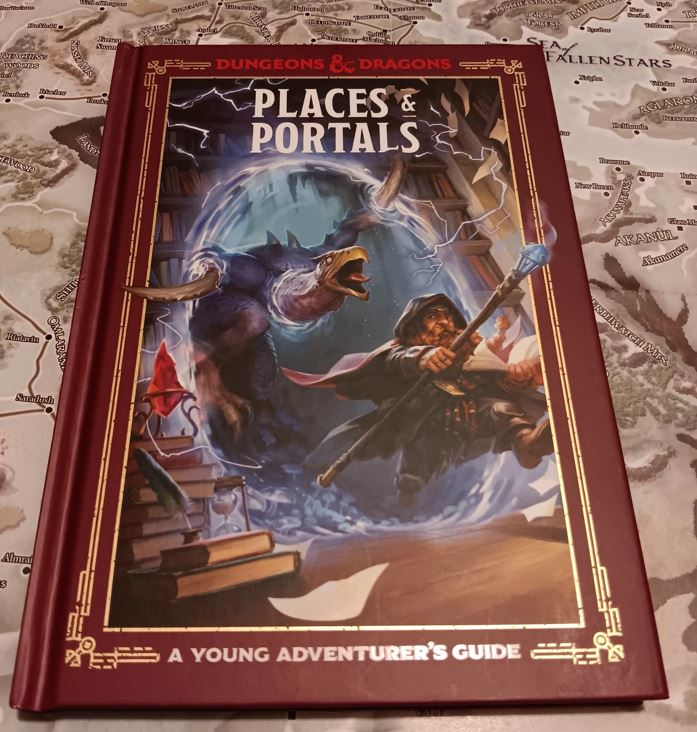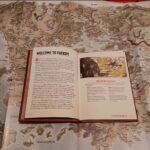How do you introduce new players,  especially young ones, to an immersive narrative game with almost five decades of collective history? If the game is DUNGEONS & DRAGONS, then one possible answer to this question is Places & Portals by Stacy King, Jim Zub, and Andrew Wheeler. This September 2023 release is the latest installment in the Young Adventurer’s Guide series, which includes over a half-dozen books – light on rules and heavy on imagination-sparking ideas – designed to guide young new players as they begin to explore the many facets of D&D.
especially young ones, to an immersive narrative game with almost five decades of collective history? If the game is DUNGEONS & DRAGONS, then one possible answer to this question is Places & Portals by Stacy King, Jim Zub, and Andrew Wheeler. This September 2023 release is the latest installment in the Young Adventurer’s Guide series, which includes over a half-dozen books – light on rules and heavy on imagination-sparking ideas – designed to guide young new players as they begin to explore the many facets of D&D.
Places & Portals is 112 pages of full-color fun, perfect for players new to the game, and tailor-made for a younger audience than most D&D releases. At about 6”x9”, it doesn’t have the “textbook” feel of the larger, more traditional 9”x12” rulebooks. I might be misjudging, but it seemed to be about a 6th-7th grade reading level, easy enough to read every word in an hour or two, but not so simple as to become boring (I spent two hours reading it cover to cover, but some of that was looking at the art and checking references). The editing and proofreading are top-notch; the only “typo” I found (which might have been intentionally left alone – I know I would have, if I were the proofreader) was a reference on page 80 to “cute planet-eating rodents the size of a brown bear” (presumably, they are “plant-eating” rodents, although with Giant Space Hamsters, who knows!).
The layout, especially near the beginning, works hard to hold the interest of shorter-attention-span readers. There are often sidebars, offset with a different font, and every two-page spread has at least a small illustration, if not a half- or full-page work of art. The sidebars use a sharp-cornered sans-serif font, while the text that carries the overarching page-to-page progression is in a Times-style smooth-cornered serif font, and while my older eyes found that transition a bit jarring, it is consistent with other contemporary books that I’ve seen. The pages are heavyweight, glossy paper, printed edge to edge in full color, and stitched together rather than glued. My inner 10-year-old is jealous: Oh, to have had this quality of printing back in AD&D Second Edition!
The art is beautiful, fantastic, and evocative, although most pieces are not intricately detailed (matching the general style of many D&D 5th Edition products). While most of the pictures are “recycled” from other D&D products (and typically appear here in a smaller format than their original printings), that only detracts from the overall aesthetic in one spot; the vast majority of the book makes excellent use of art to convey ideas and set the tone for the text. The notable exception – and my largest complaint about this book – is the tiny map of the continent of Faerûn at the top of page 5. This is a reprint of a map that, if memory serves, was a 2-page spread inside, or poster-sized print accompanying, the campaign book that the image is pulled from. This makes the place names referenced in the text – of which there are quite a few – impossible to read on the map. However, a larger map would have no-doubt come at the expense of other art, such as the gorgeous almost-two-page spread for the cityscape of Waterdeep. If you’re not already familiar with Faerûn, I suggest having a phone or tablet handy to look up a larger map of the Realms as you read the useful information and fun details about the various cities and lands.
For what it set out to do, Places & Portals does a first-rate job. At just $13.99 MSRP, it is far more affordable than the average D&D rules book or campaign setting (which typically range from $40-$70), and a great choice for someone who thinks they might want to start diving into D&D, but isn’t ready to commit the time and/or cash to a shelf full of the big books (or the parent or friend of such a person looking for a nice stocking stuffer). I would especially recommend it for young players who have worked their way through a beginner adventure, such as in the Starter Set or Essentials Kit, and want to get their feet wet exploring the wider world of DUNGEONS & DRAGONS.
Speaking of exploring the worlds of D&D, let’s explore a bit more closely what Places & Portals has to offer. The first and arguably most important part of this book (for players, although perhaps not for aspiring Dungeon Masters) is an introduction to the primary world of the DUNGEONS & DRAGONS game, the Forgotten Realms setting in the continent of Faerûn on the planet Toril. With over 400 novels, hundreds of adventures and sourcebooks, and most recently the Hollywood blockbuster Dungeons and Dragons: Honor Among Thieves, this setting is ubiquitous within the D&D multiverse. Trying to introduce the world in a way that is accessible to young new players, without overwhelming them with decades worth of lore, is daunting to say the least. And here, this book truly shines in a way that other books many times its size have failed. It gives players new to the Realms an idea of what their characters are likely to encounter in a game, and does so in a space that will probably take even young gamers less than an hour to read. There isn’t much reference to the history of the world – characters like Elminster, events like the Time of Troubles, and the many pantheons of deities that guide the Realmsfolk are largely absent from the text – but this does allow for an elegantly streamlined presentation. The authors manage to cover a trove of information, from the basics of the Underdark with its udadrow, duergar, and svirfneblin, to the Ten Towns of Icewind Dale popularized in many of the Forgotten Realms novels, all the way to the cities of Neverwinter and Waterdeep.
Beyond introducing the vast Realms in under 50 pages, Places & Portals also provides a basic introduction to a few of the most commonly explored planes of parallel existence in D&D. Following a brief discussion of the Feywild, the Shadowfell, and several other dimensions ripe for exploration, the book segues into a discussion of a few of the game options laid out in the Spelljammer campaign setting. (If you have never heard of Spelljammer, imagine if the fantasy worlds of Jules Verne and JRR Tolkien had a love child that took extreme pleasure in telling Isaac Newton and Albert Einstein exactly what they can do with “physics” in outer space.) It seems a little strange to me to loop back around from the Realms, through other dimensions, and back to Spelljammer, but they are linked settings, and Spelljammer is the most recent flagship product released before this book, so it makes sense at least from a corporate timing sense, basically placing internal advertisements. And, they do a good job weaving the potentially discordant parts together, so I would let it slide for now, even if this does promise to “date” the product in the future.
The last 16 pages are probably my favorite. Here we have the key elements of a youth-friendly Dungeon Master’s Guide, with advice on world-building your own setting (for when the Realms inspire you to go off on your own a bit!), guides for mapping and using cartography (a sadly dying skill in this day and age), and recommendations for how Dungeon Masters and Players can work together to tell a truly epic story.
Places & Portals is thankfully rules-light, to the point of essentially being rules-edition-agnostic, and promises to stay relevant even when the new 50th Anniversary edition of D&D comes out next year. As someone who has played D&D off and on for 30 years (quite intensely for about half that time) and watched five editions come and go, I am probably not the target audience for this book, but nevertheless I enjoyed it. I most strongly recommend it for new, young players taking their first step or two into the hobby (maybe after watching the new D&D movie or seeing some live-play streams online), but it can also be a fun read for older gamers like me, trying to get a quick refresher on the Realms.
We would like to thank Wizards of the Coast and Ten Speed Press for sending this review copy.
-Landon Bellavia



